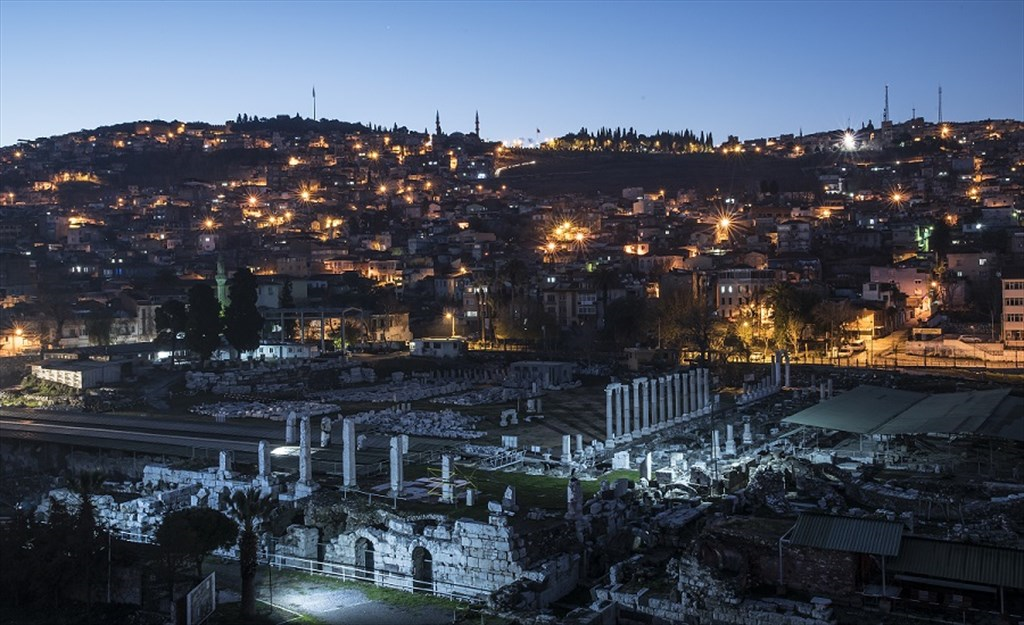Agora Ruins
İzmir agora was established on the north facing slope of Pagos (Kadifekale) where the ancient city of Smyrna was moved in the 4th century BC. Surrounded by important public buildings of its period, the Agora building was the Capitol building of Smyrna city state. Most of the surviving ruins in The Agora, which was established in the Hellenistic period, belongs to the Roman period, which was rebuilt with the support of Emperor Marcus Aurelius after an earthquake in 178 AD.
The history
Agora, which is a Greek word, means 'meeting place, city square, bazaar, market place'. It is known that in ancient times agoras were the focal points of the cities, where artistic activities were condensed and many social events took place or carried out alongside commercial, political and religious functions were executed. There is at least one agora in every city in the Ancient Age. In some big cities, there were generally two agoras. One is the state agora, where state affairs are held, around which various public buildings are gathered and the other is the commercial agora where commercial activities are conducted. The Smyrna Agora is a structure planned as a rectangle, which has a courtyard in the center that is surrounded by galleries (stoa) with columns. Unearthed by excavations the north and the west stoas that are rising above the basement floor. The north stoa is a basilica in terms of its architectural features. Basilicas are structures that are planned with parallel corridors which are wide and have high ceilings in the center and narrow with low ceilings on the sides. The Roman Period basilicas, which pioneered the Christian churches in terms of their architectural features, are a kind of courthouses where the legal affairs of the city were took place. On the other hand, basilicas have been preferred for the activities of merchants and bankers who lead the commercial life of the city. The basilica located in the north wing of the agora has a rectangular plan, measuring 165 x 28 m from outside. Smyrna agora basilica has the distinction of being the largest known Roman Period basilica in terms of dimensions. The cross vaults seen on the east and west ends of the magnificent basement that survived to this day, are among the most beautiful examples of Roman Period architecture. From the two monumental gates opening to the basement on the north facade of the basilica, the west one has been completely unearthed today. Towards the end of the Roman Period, the cross vaulted shop rows, indicating that the state agora was gradually gaining a commercial meaning, were unearthed on the northern facade of the basilica. The west stoa which is composed of naves that are separated by 3 rows of columns, was also rising on a basement floor like basilica. It is understood that the western stoa, which is mostly seen of its arched basement floors today, was a two-story building rising above the basement floor in antiquity. The ground floor, which can be climbed from the courtyard with three steps, and the second floor with wooden floors, were the places where people used to walk protected from rain and sun in ancient time. The cisterns which presumably built by repurposing old galleries by the end of The Roman period, are the best examples of its kind. The first floor columns of the west stoa facing the courtyard were erected in the 1940s. The columns that has some architectural defects and the ground on which they stand, are restored with contributions of İzmir Chamber of Commerce. The Ancient Street which is one of the east-west direction street of the grid planned city was roughly dividing the city into equal sections. There was a magnificent gate where the street enters The Agora called the Faustina Gate. At the center of the northern arch of the gate, which is thought to have two sections, is the portrait relief of Faustina, the wife of the Roman Emperor Marcus Aurelius. On the second section there probably was an arch that had the relief of Marcus Aurelus which should be under the street currently in use today since smyrnian people wanted to show gratitude to these two people who have reconstructed the Agora after an earthquake in 178 C.E. The arched gate which was reconstructed with inadequate measurements in 1940's, was restored to its original form in 2004. Graffiti and the murals from Roman period have been found on the plaster at the basement of basilica and abutments of the arches. Apart from those drawn with an ink that is a mixture of Iron and Oak Root, there are also examples made by scraping. Graffiti reveals very important information about daily social life, especially in the Roman period.It has been determined that graffiti includes many different subjects, from love games to gladiatorial struggles, from sexuality to sailboat paintings, from beloved names to birds, ships and riddles. From the city slogans seen in the graffiti, It is possible to observe the rivalry between the three shining cities of Western Anatolia, Pergamon, Ephesos and Smyrna, manifested itself even among the people in the Roman period. The graffiti uncovered in the basement of the Smyrna Agora basilica are unique in various ways. Firstly, these discoveries indicate that the graffiti are the oldest made with a substance containing iron and oak root. Further, while the written sources that have been obtained in the World Antiquity studies until today are generally official and religious, the Smyrna Agora graffiti written in Greek reflect the traces of the daily life of the people. Basilica graffiti also hides important clues about the early Christianity. Another important feature of graffiti is that they are the most comprehensive graffiti in the world in terms of depiction. These features place the graffiti of Smyrna as one of the unprecedented discoveries in the archeological literature.

.jpg)
.jpg)
.jpg)
.jpg)




.jpg)
.jpg)
.jpg)
.jpg)


Comments
No comment left, would you like to comment?